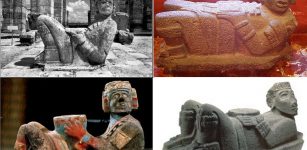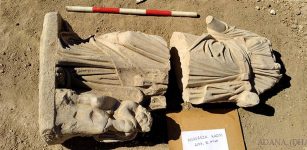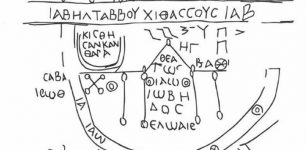Ancient Temple Dedicated To Aztec God Xipe Totec Discovered In Mexico Reveals A Gruesome Story
Conny Waters - AncientPages.com - Xipe Totec was an Aztec god worshiped by people across what is now central and western Mexico and the Gulf coast. It was a fearsome deity who according to the Aztecs invented war.
He was known under different names such as Tlatlauhca, Tlatlauhqui Tezcatlipoca and Youalahuan. In Aztec mythology he was as the god of life, death and rebirth as well as agriculture.
Xipe Totec as depicted in the Codex Borgia, shown holding a bloody weapon and wearing flayed human skin as a suit. Credit: Public Domain
Nevertheless, Xipe Totec ("The Flayed God") was mostly associated with gruesome sacrifices. Wearing a pointed cap and rattle staff he was often depicted without his skin as as a golden god. Aztecs believed Xipe Totec had flayed himself to give food to humanity.
His great temple Yopico was located in the capital city of Tenochtitlan, which is now Mexico City.
As mentioned earlier on Ancient Pages, Templo Mayor was a sacred Aztec complex dedicated to several gods like Tlaloc and Huitzilopochtli who were usually appeased with human sacrifices. Within this complex, Aztecs also built a temple in honor of Xipe Totec ("The Flayed God").
Among the ruins of the Ndachjian-Tehuacan, an archaeological site in the central state of Puebla archaeologists have discovered an ancient temple dedicated to god Xipe Totec.
The temple was used from around the year 1000 until about 1260. Horrible sacrifices took place there. According to Mexico's National Institute of Anthropology and History, the temple’s priests ritually sacrificed their victims on one of the temple's two circular altars, then flayed them on the other and draped themselves in their skin, Associated Press reports.
The Ndachjian–Tehuacan archaeological site in Tehuacan, Puebla state, Mexico. Credit: AP/Mexico's National Institute of Anthropology and History.
At the site Ndachjian-Tehuacan, scientists unearthed “three stone sculptures of Xipe Totec: two skinned heads and a torso, whose back is covered in engravings representing the sacrificial skins worn by the god.
See also:
Linked Human Skeletons Lying In Spiral Circle Unearthed In Pre-Aztec Burial Pit Near Mexico City
500-Hundred-Year-Old Mystery Of Aztecs’ Death May Have Been Solved – New Study
Was Aztec And Mixtec Turquoise Mined In the American Southwest?
"Sculpturally speaking it's a very beautiful piece. It measures approximately 80 centimeters (30 inches) tall and has a hole in the belly, which according to historical sources is where a green stone was placed to 'bring it to life' for ceremonies," said Noemi Castillo Tejero, the lead archaeologist on the project.”
As one of the most important gods in pre-Hispanic Mexico, Xipe Totec was worshipped in a ceremony called Tlacaxipehualiztli, which in the indigenous Nahuatl language means "to wear the skin of the flayed one."
A statue of Xipe Totec, a pre-Hispanic god whose priests sacrificed humans and then wore their flayed skins on their own backs as part of a fertility ritual in what is now Mexico. Credit: AP/Mexico's National Institute of Anthropology and History .
Researchers say “sacrificial victims were killed either through gladiatorial combat matches or by being shot with arrows, then flayed to glorify Xipe Totec, it said.
Their skins were then buried at the foot of the altars.
Two holes filled in with earth were found in front of the altars at the Ndachjian-Tehuacan site.”
When the Spanish conquistador Hernan Cortes and his army arrived in and took over Mexico they put an end to these horrifying rituals.
Written by Conny Waters – AncientPages.com Staff Writer
More From Ancient Pages
-
 Ancient Egyptians Had The First Governmental Health Care System
Ancient History Facts | Jul 6, 2018
Ancient Egyptians Had The First Governmental Health Care System
Ancient History Facts | Jul 6, 2018 -
 Incredibly Well-Preserved Viking Age Ski Discovered Under Melting Ice
Archaeology | Nov 8, 2022
Incredibly Well-Preserved Viking Age Ski Discovered Under Melting Ice
Archaeology | Nov 8, 2022 -
 Ancient Roman Sandal With Nails And Game Pieces Found Under A Playground In Germany
Archaeology | Nov 22, 2024
Ancient Roman Sandal With Nails And Game Pieces Found Under A Playground In Germany
Archaeology | Nov 22, 2024 -
 Unusual Iron Age Cemetery Discovered In Dorset, UK
Archaeology | Jul 11, 2022
Unusual Iron Age Cemetery Discovered In Dorset, UK
Archaeology | Jul 11, 2022 -
 Ancient Hindu High-Tech That Contributed To Modern Science
Civilizations | Nov 11, 2014
Ancient Hindu High-Tech That Contributed To Modern Science
Civilizations | Nov 11, 2014 -
 Mystery Of Famous Viking Ruler Rollo: DNA Experts Seek The Truth About His Identity
Featured Stories | Mar 16, 2016
Mystery Of Famous Viking Ruler Rollo: DNA Experts Seek The Truth About His Identity
Featured Stories | Mar 16, 2016 -
 Extremely Unique Ancient Roman Arm Guard Found At Trimontium Fort – Restored And On Display For The First Time Ever
Archaeology | Jan 22, 2024
Extremely Unique Ancient Roman Arm Guard Found At Trimontium Fort – Restored And On Display For The First Time Ever
Archaeology | Jan 22, 2024 -
 Biblical Jonah Visits Nineveh – The Evil City
Biblical Mysteries | Nov 9, 2018
Biblical Jonah Visits Nineveh – The Evil City
Biblical Mysteries | Nov 9, 2018 -
 Mystery Of The Avars Who Conquered The Roman Empire Solved By Scientists
Civilizations | Apr 1, 2022
Mystery Of The Avars Who Conquered The Roman Empire Solved By Scientists
Civilizations | Apr 1, 2022 -
 Huehueteotl: Old Aztec God Of Fire, Time And Aging – Ceremony Of The New Fire
Aztec Mythology | Jan 31, 2019
Huehueteotl: Old Aztec God Of Fire, Time And Aging – Ceremony Of The New Fire
Aztec Mythology | Jan 31, 2019 -
 Mysterious Chakana – Sacred Inca Cross And Its Connection To The Southern Cross Constellation
Ancient Symbols | Sep 15, 2018
Mysterious Chakana – Sacred Inca Cross And Its Connection To The Southern Cross Constellation
Ancient Symbols | Sep 15, 2018 -
 How Is DNA Preserved In Archaeological Sediments For Thousands Of Years
Archaeology | Jan 3, 2022
How Is DNA Preserved In Archaeological Sediments For Thousands Of Years
Archaeology | Jan 3, 2022 -
 Forgotten Ancient Kingdom Of Tuwana Is Hidden Among Ruins In Cappadocia
Civilizations | Mar 12, 2016
Forgotten Ancient Kingdom Of Tuwana Is Hidden Among Ruins In Cappadocia
Civilizations | Mar 12, 2016 -
 Image Of The Day: Chacmool – Famous Ancient Statue Of Pre-Columbian Mesoamerica
Image Of The Day | Sep 10, 2015
Image Of The Day: Chacmool – Famous Ancient Statue Of Pre-Columbian Mesoamerica
Image Of The Day | Sep 10, 2015 -
 Archaeological Evidence Ancient Egyptians Visited South America
Ancient Mysteries | Jan 7, 2020
Archaeological Evidence Ancient Egyptians Visited South America
Ancient Mysteries | Jan 7, 2020 -
 Extraordinary Discovery Of ‘Time Capsule’ Belonging To Jules Verne – It May Contain Unpublished Works
Archaeology | Apr 19, 2017
Extraordinary Discovery Of ‘Time Capsule’ Belonging To Jules Verne – It May Contain Unpublished Works
Archaeology | Apr 19, 2017 -
 Can This Ancient Underwater Graveyard Solve The Mystery Of The Great Flood And Noah’s Ark?
Archaeology | Oct 23, 2019
Can This Ancient Underwater Graveyard Solve The Mystery Of The Great Flood And Noah’s Ark?
Archaeology | Oct 23, 2019 -
 Statue of Goddess Hygieia And Eros Unearthed in Ancient City of Anavarza, Southern Turkey
Archaeology | Dec 7, 2017
Statue of Goddess Hygieia And Eros Unearthed in Ancient City of Anavarza, Southern Turkey
Archaeology | Dec 7, 2017 -
 A Remarkable Curse Tablet Dated To the 1st Century AD – Unearthed In Tongeren
Archaeology | Jul 10, 2020
A Remarkable Curse Tablet Dated To the 1st Century AD – Unearthed In Tongeren
Archaeology | Jul 10, 2020 -
 Full-Sized Model Of Noah’s Ark Created In The U.S. To Show People The Evolution Theory Is False
News | Oct 20, 2022
Full-Sized Model Of Noah’s Ark Created In The U.S. To Show People The Evolution Theory Is False
News | Oct 20, 2022



